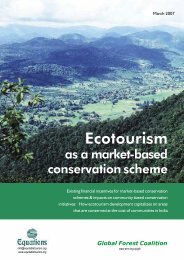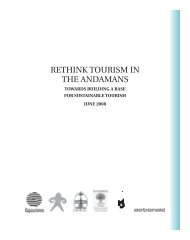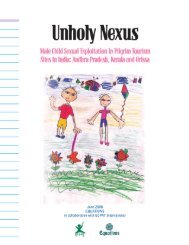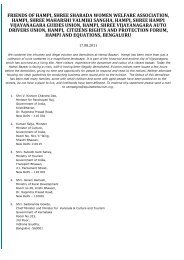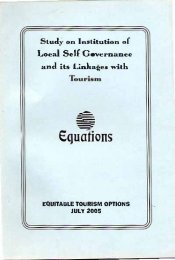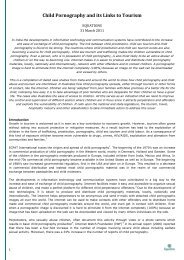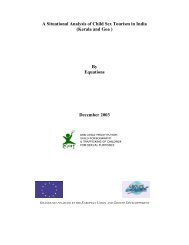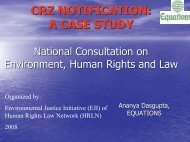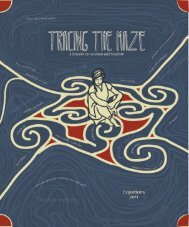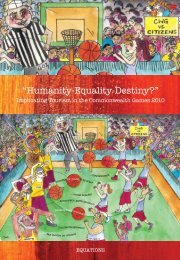'Alternative Network Letter Vol 7 No.3-Feb 1992-EQUATIONS', 3.09Mb
'Alternative Network Letter Vol 7 No.3-Feb 1992-EQUATIONS', 3.09Mb
'Alternative Network Letter Vol 7 No.3-Feb 1992-EQUATIONS', 3.09Mb
Create successful ePaper yourself
Turn your PDF publications into a flip-book with our unique Google optimized e-Paper software.
~~IIjut4 E~Vaijayanti Kulkarniworld famous AJanta and Ellora caves will soon have a newlook. Thanks to the Japanese government which has extended itscooperation to preserve this ancient monumentBuddhism has tor long been practised in Japan. This may be theraRson why a Japanese institution has come forward to conservetnese monuments which beautifully depict scenes from the life ofBuddha. Trle Ajanta caves are renowned for their mural paintings.The C3ves (200 BC to AD 700) are endowed with beautiful wallpaintings, a perfect specimen of Indian art.Though unique, the Ajanta-Ellora caves do not attract as manyforeign tourists as some other popular destinations in India, such asTaJ Mahal in Agra or the beaches of Goa. This is mainly becausethe government of India has always concentrated on the northernGolden Triangle. Another reason being the poor infrastructural1cilities available at Aurangabad.However, a large number of domestic tourists visit these caves,which are not yet surrounded by unhealthy commercial activities. Butwith the ravages of time and tourism, they are in danger of beinglost forever. Smoke, dust and the centuries old preservative coatshave obscured some of the Ajanta paintings. The necessityto preserve these caves and upgrade their surrounding was felt toensure that the great heritage is properly preserved and the touristsexperience is more aesthetic.With this thought, Maharashtra Tourism Development Corporationhas prepared a project report to implement the conservation of thesemonuments. The state government has given the green signal forthis ambitious project.The package for development includes conservation of Ajanta andEllora caves by modern chemical treatment to prevent deteriorationand help preserve and enrich the environment of the region throughmassive afforestation. Also on the anvil is a plan for the all rounddevelopment of the surrounding countryside through better railwaynetwork, better and wider black-topped roads, improved water supply~nd sewerage, supply of electricity, modern eiectronic telephone;changes and telex services. The project also envisages the settingup of reception centres for visitors and provision of allied facilitiessuch as landscaping, battery-operated car coaches and shuttles toreduce pollution, training courses for guides and computerisedmanagement of tourists arrival, stay and departures.The facilities will also include astandard. An institute for study of rock-cut caves and sculptures willalso be set up. Besides, there will be meditation centres, viharasand facilities for scholars and hails to hold lectures, seminars andconferences.Provision will also be made for parking cars, restaurants, rest places,picnic spots, parks and recreational facilities, Craft centres, shoppingcomp:exes and an amphitheatre are also planned.All these facilities will be set up at a distance ot at least 4 km fromthe Ajanta caves so as not to disturb the tranquility and serenityof the monument. Industrial and other activities within specified,'adiiJs h}fil the f1IOiil.dTlents ~vill be disailowed so as tc ITlaintain theecological balance of the project area.A light and sound show at the famous fort of Daulatabad will alsobe introduced. The proj8ct is expected to give a massive thrust to3which will contribute to the earning of foreign exchangefor the country. It will also augument the development of theeconomy in this area. The project is expected tb add to the employmentpotential for local youths and will give boost to the local arts andcrafts such as Paithani sarees, Himroo shawls, Bidri works and thelike.The total cost for this project which will be executed in two phasesworks out to Rs. 195.614 crore. Or the total cost, the stategovernment w:11 share Rs. ~ 39.73 crore, the centre will contributeRs. 32.88 crore anc the private sector Rs, 23 crore.For the first phase of the project which will commence in 1 theOverseas Economic Cooperabon Fund (OECF) of Japan hasan outlay of Rs. 75.658 crare by way of soft loan ofyens carrying a nominai interest rate of 2.6 percent to be refundedover a period of 30 years, including a moratorium of 10 years.The loan will be advanced by OECF under bilateral agreement tobe entered with the Government of India ~nder the aegis of AidIndia Consortium, comprising 13 advanced countries and internationalfinancing organisations, which recentiy announced in Paris a loan of$6.7 billion for various development projects in India including theAjanta-E lora Tourism Development ProjectThe outlay for the second phase of the project which will commencein 1994 is about Rs. 120 crore. The total outlay of the stategovernment for the first and second phases of the project duringeight five-year plan period will be Rs. 102.85 crore, The remainingexpenditure of Rs. 36.88 crore will be provided in the ninth five-yearplan. The project is expected to be completed by 1998.- The Independent (Bombay) 14 October, 1991PARADISE LOST Sally MathewIf Chester Bowles ever had Mahabali's 'granted wish' and couldreturn to Kovalam today, there wouldn't be any "athapoovu" or'nirapara' to greet him. Instead, he would see hundreds of vendorsand stray dogs! The 'paradise on earth' that Bowles found on thesands of Kovalam beach is going fast and so is the beachitself, taking the tourists with it!Hawah Beach, the gOO-metre stretch between Vizhinjam lighthouseand Sea Rock Beach, was once a sparkling sandy beach with thelighthouse point and sunset rocks serving as a beguiling backdrop.That beach does not exist anymore. In its prace is a gOO-metre rowof rickety and unsightly huts housing over 24 restaurants and 10shops. Now, if you need to go from Sea Rock Beach to thelighthouse you must either walk in the water or throuah the insideof several restaurants.Adith Kumar owns a hotel on Light House Road, just off HawahBeach. He said, "In mid-1989, the State Government clamped downon the unauthorised encroachement of the beach and a demolitionsquad arrived on the site. But, alas, politics got the best of sanityand the hutment owners, through the local MLA, who was then aminister, and the local Panchayat member managed to get a 'stay'and the demolition squad was sent away". The stav still remains ineffect.According to Kumar, tile demolition would not hlil1 anyone, He s'aid,"the owners of most of these hut-restaurants and shops own theproperty behind too, If they would move back to th:::ir property,
the beach as it was meant to be, they could continue doingbusiness with unrestricted seaview and perhaps would do better fromall the extra people spehding more time at the beach". Sunset Rockwas always apopular spot fortourists enjoying the magic of abeautifulsunset. Today the rocks are almost inaccessible. And, if one reachesthe vantage point inspite of the arrack shop and the drunks hangingaround, it is difficult to stay there long enough to see the sun setting,with all the filth."Sunset rocks have become lavatory for the hutment dwellers andthe garbage dump for all those hutment restaurants," said Salladeen,manager of a local hotel and a Kovalam native. Sea Rock Beach,is the only sandy stretch remainig for the 'non-ITDC class'tourists.Another major problem is the lack of public toilet facilities, even atmost of the restaurants. Kovalam just doesn't make it easy for thetourist. For instance, there is no tourist Information centre, not evenan area map or bus schedule to help the tourist. Kovaiam post officeis over three kilometres away from the tourist area. In fact, aroundthe bus terminal there isn't even a mail box or a coin operated publictelephone booth.Besides the major hotels, there isn't anywhere for the tourist to cashmoney. The availability of the facilities in these hotels is notmade known to the predominant "non-five star" tourists and consequentlymany tourists, out of sheer necessity, resort to the illegal exchangeof money. "A tourist police force was promised by the previousgovernment," said Salladeen, "but we haven't seen it yet". Suchpolicing might help keep the "money changers", hotel touts, pimps,drug pushers and other undesirable elements away from tourists.Other complaints regarding Kovalam are antisocial activities such asprostitution and illegal drugs. Also the fact that pipe water supplyend at Sea Rock Beach and Hawah Beach hotels and restaurantsoffer weI! water to its guests. Several sources, who were reluctantto be quoted, said that urine and garbage seep into these wells andthere are literally hundreds of dysentery cases treated in Kovalamthe tourist season."treatment" and this illness isrid of stray dogs andIMllthMiC'orl encroachments of the beaches, restricting areas fortiding basic necessities like clean bathrooms, touristInfnrmation and communication facilities are just some of the immediateim!,\I'Vt"lnt necessities to save Kovalam before it's too late.- Indian Express, 6 October, 1991.Chile: Sacred Ground ExploitedRecently I lived on Easter Island for a year and found that thereis excessive exploitation going on there. I worked briefly with thePresident of the Council of Elders, a group of natives formed of onerepresentative from each of the 36 original island families. He waspreparing a plea to the outer world forThe occupation by Chile, 100 years ago, has neverfor EaSler Island. None of the agreements were lived~inal contract which was signed by force.revolution, but want just treatment. Their is threatened innumerous respects. One being their own President Pinochetof Chile, has been trying to gain leaal title deed to the entireexcept for the village area.I have filed a report with the United Nations Human Rights Commissionin Geneva proposing that the Council of Elders be given theriQht to exist under law and be heard by their sovereign nation, Chile.There are further proposals in the report which could shed light onother sources of exploitation. .The governor, a Pinochet-appointed man, allowedon three giant stone statues (moais) in June of 1988,damaged them. After knowing of the damaae. hehave yet another cast. Shortly therremove a massive amount of rock, in collaboration withServices of Chile (CONAF) near the most extensive archaeloaicalsite, the quarry, Rano Raraku. This is madness; there wouldbe many archeological treasures there, as there are many petrothatarea and it was the main activity Genter during theEra on the island. The Council of Elders was outraged, buthad no recourse, as they have no legal say about anything. The onlycan 'do is bring lawsuits to be heard, which is expensiveno income.governor holds a permanent position as director of the IslandMuseum. One native islander entrusted an original artifact to hi2museum and never saw it again. The Easter Islanders are very awarethat their island has lost, unfairly, most of what they consider theirsacred relics. they even believe that their island, as a result of this,has been stripped almost completely of her mana (their word forsupernatural powers). Every native islander still believes today thatthe moai were moved from the quarry to platforms allover the islandvia mana. The varying theories scientists have claimed as "solutionsto the Easter Island Mystery" may be as feasible as thelegend. The islanders deserve to have their sacred relics returned,and to gain the right to protect their heritagESince the report has been filed with the UN HumanI have been informed that Chile is working in collaborationwith Club Med to take over the beach of Anakena. This is one ofthe most prestigious archeological sites in the world and the onlybeach the islanders may enjoy (there is only one other, tiny beach).Club Med would provide all of its own staff and keep the beachexclusively for its members. Thus, the island would not benefit ata!1 from this invasion, except to sell a few more moal carvings. Thebeach is also considered sacred to the islanders because theiroriginal ruler, King Hotu Matua, first set foot on that location whenhe first landed. To this day islanders do not like too many noisy (,disrespectful activities happening there.Keeva Kroll, Seattle, USA (Cultural SUivival Quarterly, 13(3), 1989.}HAVEN OF HASSLES Srinand JhaHere is God's plenty: lush-green valleys, rocky ravines, flowerdeckedmeadows and snowtipped mountains to thrill the most fastidioustourist. The terrain is rich with people of exotic cultures and languages.Yet the tiny Himachal Pradesh is still waitina to be discoveredby travellers from distant shores.a tnougnt to developingShanta Kumar of the BJP wasbrimming with ideas' when he took over as chief minister. He keptthe tourism portfolio with himself and went ahead with plans forrevolutionising the very face of tourism. He has found the publicsector a great put-off and his one big dream is to privatise the tourismsector and to make it the leading industry. But even before he couldget off the starting block, controversies started plaguing him and4
Another fear is that uncontrolled green tourism will result in theovercrowding and degrading of the same wilderness areas thatattracted visitors in the first place. One site, the January Lake, acrossthe Rio Negro from Manaus,is often cluttered with boats visiting giantwater lily pads. "Carrying capacity is the key word", said SilvanaCarnpello: a Brazilian biologist who administers programs inBrazil for the United States' Nature Conservancy. " Eco tourism isnot the destination, but wilat you do when you get there".But caveats not withstanding, most environmentalists said thatimproves the prospects for survival of the forest. Theypredict that tourists - foreign and Brazilian will create an informedinternational constituency for its defence. "It is easy to sit in an airconditionedroom and say, "We need to save the trees," EugeneAull, a tourist from New York, said as he relaxed from a river trip.'There is incredible poverty down here. You have to aive themsomething in return ."Peter N Lahanas, a University of Miami biologist who served as tourguide added, "These people are more informed, they will have a realimage when they get back. The next time someone knocks on theirdoor asking for money for the rain forest, they will give."- New York Times, 19 May, 1991.~~EIj~¥4Thank you l'ely much for highlighting ollr Antarcticain your recent issue of ANL. It is very close to our heart andthe definition of a Peace Park is carrying, we believe,principles which could well be applied anywhere in the worldand help establish a link between grass root peoples who seekto restore health to all the many diflerent relationships 'withour natural environment. We see it as an ongoing venture andvel)' much in harmony with the essential ideas of Newl'ow·ism.Yes, as you will realise, we completely agree mass tourismis poisonous to -the integrity of any people or country andseems to stimulate greed, had taste and gluttony in bothvisitor and host. Tourism is so closely linked with the policiesof local governments and industries as to how they developand exploit the country's /latural resources.One thing is hecoming ahundantly clear, not just in Sarawakand Malaysia hut in most other countries as well: there i:., aninconceivably wide gap hetl1'een the text of glossy pamphletsand reports on government policies with regard to forestry,tourism, industrial waste and pollution PIc., assuring citizens,visitors and customers of clean, green, caring and sustainablemanagement - and what happens in reality. More and morehowel'er, are beginning to feel that something isseriously wrong, and enrironmentalists (scientists and doctorsamong them) are alerting the world to the shortsighted,and selfish wheelings and dealings with the earth'snatural resources and the shamefully unfair distrihutionthem. Theory alld practice of government policies and commitmentsare (~ften so far apart that you would not know,unless actually told, that one was related to the other.7One cannot help wondering !l some type qf UN peace keepingforce. men and women who were uniJiased und reliable andacceptable to the family (~l nations could he estahlished toguide, stlpel'l'is(! alld encourage right action in these matters,thus lessening the gap betvveen theory alld practice, aspirationand application. May be such a peace keeping force couldalso serve as a hridge between governments, industries andell vironmentalists , 'who today can lend to slow up the processof healing through long and mutually hur(/IJ/ confrontations.Such a group might also provide the world with reliahle andhalanced information, which takes the whole siruaTion intoaccount and therefore presents each issue to the world'speople as openly and un-biased as possihie. Upon suchinformation decisions can be made which will serve andhenefit all and inspire everyone to participate in a corporatethrust to put our house in order and make it heautiful. I thinkeveryone agrees that it is us, the people of the world, thatmust bring changes about. However well intentioned a governmentmight be, it cannot hring the promised changeswithout the combined efforts of individual human beingswithin all walks of life. So mayhe one day we shall he ableto arrange a 'new tourism' meeting here in New Zealand,inviting people from Malaysia, South Pacific Islands andmany other places. It is certainly an issue which touches somany areas of society and could bring such blessings topeople's lives instead of tragedy as is now so often thecase. Let's see if such a meeting wants to happen!GITABROOKEOperation Peace Through Unity, 'Te Rang;', 4 AllisonStreet, Wanganui 5001, New Zealand.I am told that you have set up an alternative Tourism Nern/orkwhere tourists interested in the social aspects of the variousmovements in India contact YOll, and you work out for theman alternative trail. I would he very interested in collaboratingwith you on this because I find many tourists very sincere andsocially committed and we have had very positive experienceswhen we put them in touch with social organisations andactivists groups. More particularly, if you would include usin your nernJork, we could arrange to put persons who visitBombay in touch with various individu.als and groups in Maharashtraand particularly, if the visitors are willing to livein a particular m'eafor some time and work among the peoplewe can provide certain support structures for (his kind ofinvolvement .Since we do a lot of public interest work we do need peopleto work with activist grou.ps in various areas and, in theprocess, draft puhlic interest petitions.ll.vas therefore quite enthused when I heard about your effortsana I would like to know whether we can work together onthis.COLIN GONSflLVES - Desai, Singh & Gonsalves (Advocates) Engineers House, 86 Apollo Street, Bombay-400 023.
PEQFECT Ht\QMONYVeenu SandalThe conflict between tourism and the environment is perhaos thestiffest challenge, the biggest dilemma facing the travel andindustry today. Recent years have witnessed a boom in the touristtrade. Closely allied as it is to a steady growth in disposable orexpendable personal incomes, tourism has prospered and flourished,particularly in the northern states of Jammu and Kashmir, UttarPradesh, Himachal Pradesh, Rajasthan, Haryana and Madhya Pradesh.But this very success of tourism has begun to degrade the environment,out the adage, "tourism destroys tourism". If handledcan provide a spectacular boost to state economies,as was the case earlier in .J & K. If allowed to develop on an adhoc basis without any long term perspective or plan, as is happenin.-.in most hill stations, it could well destroy both the environmentthe tourist trade. As a result, the inseparable link between tourismand the environment is the single most contentious issue thatcurrently exercises the minds of planners.The Ministry of Environment and Forests and the Ministry of Tourismhave long been at loggerheads over the matter of planned development.While many of the viewpoints continue to differ, there are welcomesigns of a thaw. Appalled at the growing instances of unbridiedKamal Nath, Ministry of State for Environment and Forestsout plans to ensure that tourism does not indulge in.,.......,"""n+ exploitation of the environment."One of our major thrusts is going to be to reconcile efforts for theprotection of the environment and development of tourism. There isno reason why tourism cannot be environmentally compatible - butthis calls for a dynamic mass awakening programme."Recognising it as "one of the biggest problems" the Ministry ofTourism too is voicing an increasing concern for the el1'Jironment.However, the ministry is of the view that tourism cannot be dispersed·at will. Basic infrastructure such as construction of roads and hotelsare an integral part of the development of tourism. Yet it is aninescapable fact; the more the tourists, the more elaborate theand so quicker the degradation of the environment.Jayanta Sanyal, additional Director General of Tourism, disclosedthat concerted attempts are underway to sensitise people in thetourist trade to the dangers of over-exploitation of the environment.However, Sanyal acknowledges that poor implementation is a problem."At the micro level, a number of adverse factors come in to play,such as lack of adequate control by local authorities, the profiteeringand economic gain motive, vested interests and so on".There is no incentive for a single hotelier to SlOp unless he is surehis competitors will do so as well. This is precisely what happenedin Kashmir. A wave of newly built houseboats threatened to overcrowd(and pollute) the blue waters of the Dallake, besides(often under the counter) on the State's natural resourcesincreasing amounts of sweet scented cedar wood for building thehouseboats.Finally, to protect the environment, the state governmenthad to impose a ban on the further construction of houseboats.Significantly, the other state governments too have started initiatingmeasures to control tourism so that the carrying capacity is notexceeded or the countryside despoiled. In UP's world famous Valleyof F.lowers, the state government concerned at the ecological damagebeing caused to the delicate flora of the valley by a growing numberof tourists, banned overnight halts and camping.8INDIA ~to curb the exploitation of the environment, there mustbe an agreement on self regulation within the industry antricky affair because of the profit motive, or an imposition of rulesfrom the government. A third avenue of environmental protection andthe balanced development is being explored under the auspices ofthe International Youth Centre.Dr. Indira Koithara, programme director at the IYC, makes some vitalobservations and stresses the role that tourists themselves can playin the coming years. According to Dr. Koithara "there is littlerealisation among tourist promoters and tourists that environmentaln~,,+al"til'\n is in their own interest.How can tourists be expected or persuaded to pay attention to theenvironment? "Tourists can contribute greatly towards the environmentalprotection. 11 would make a healthy difference and tourism and theenvironment could co-exist in a far happier manner than they dotoday if even half of the total number opt to live in tents, walk andtrek over natural trails, and become conscious of the damage thatdiscarded non-biodegradable garbage and an appetite for firewoodcan cause," points out Dr. Koithara.In Rajasthan, where environmental damage has been minimised duelargely to planned development, plans are underway to createawareness among locals on a diverse range of issues. Mr. V.P.deputy director at the Rajsthan tourism bureau said that inorder to sustain tourism, parity has to be maintained between tourismand environment. "Neglecting the environment would in the long run,result in the decrease in tourist traffic, which would affect theeconomy of Rajasthan, a development that the state can ill afford."In Haryana the carrying capacities of different places are beingworked out and then dovetailed, if possible, with programmes thatare mutually attractive and beneficial for both the tourists and locals.However, knotty problems still remain to be tackled, such as thereduction (due to human ingress) of the habitat of the Indian blackbuck once a star tourist attraction. The scrapping of the Rs. 50crore Disneyland project in which some 4000 acres of forest reserves,a hill top and prime land near Dandama lake would have beer.swallowed for an amusement park, nas brought cheer to theenvironmental lobby.UP and HP have both seen in recent years the emergence ofenvironmental pressure groups and movements at the grassrootlevel. Sunderlal Bahuguna, the acclaimed Chipko movement leader,said the excesses of mass tourism must be countered. "Bhutan limitstourists to less than 2000 a year. Why can't tourist numbers beregulated in UP and HP as well?" he asks.stations such as Mussoorie, which registered an estimated 30per cent increase in tourist traffic over last year, and Shimla. aredying -- choked by a surfeit of tourism.The entertainment tax has come to stay in most states. Why notan environment tax? Mass tourism cannot be wished away. Welcomeor unwelcome, it is here to stay. The search has already begun, butin the years ahead, the northern states will have to find moreeffective ways to keep alive their economies, places of interest andthe dreams of holiday makers alive.The Economic Times, 2 August 1991Ne
News & ViewsOver The HillChristopher Coleridge with Nabanita Dutt"Even God could not solve the problems of Darjeeling," says anaged schoolmaster and resident of the hill station. And he's not theonly person to feel this way about what was once termed the Queenof the Hills. More and more locals and some outsiders as well- are beginning to despair of Darjeeling. Not only have·civic facilitiescompletely broken down in the region, the prinCipal revenue-earners,the tea and tourism industries, no longer bring in the kind ofdid earlier. Consider the facts - and figures. Tea plantationsin the Darjeeling area numbered 102 in the Sixties. By 1987 thefigure had dropped to 85. The activities of the Gorkha NationalLiberation Front (GNLF) and the resultant violence resulted in productionfrom 13 million kg/annum in '86 to 11 million in '87, with a crop valueloss of Rs. 2.5 crores.Tourism was hit just as hard. In 1985, 1,40,000 tourists had cometo the hill resort; two years later only a handlful of people bravedthe GNLF agitation to visit the region. As GNLF president SubashGhisingh got more and more aggressive, the authorities refused toallow foreign nationals entry into the area, for security reasons. Thishad an even more detrimental effect on the tourist trade.A glimmer of hope was, however, held out when a compromise wasworked out between the Indian government and the GNLF. For long,residents of the area had complained that matters could onlyimprove if the administration was given over to the locals. Finallythat demand was met in 1988, with the constitution of the DarjeelingGorkha Hill Council (DGHC). But if this move was expected to heralda prosperous restructuring, the result proved to be rather disappoint-Local officials, appear to be making little effort to make the lot ofthe tourists easier. For instance, there appear to have been little hairslost over the taxi drivers' habit of grossly overcharging passengers.It is not just taxi drivers who are greedy: 'worldliness' bas permeatedmost of the population, and some see its growth as central toOarjeeling's problems. Says Ranjit Thapa, a local restaurant owner:"The simplicity of the hill people has been swept away by greedyyoung men filled with Western ideals." Others think that the rot setin during World War II. when European soldiers were sent toto recuperate for two months at a time. Attempting toin any way they could, they created inflationarypressures in the local economy.Further discouragement to tourist traffic is provided by the civicfacilities that exist - or more accurately, do not exist - in Darjeeling.The condition of the roads, for one, is abysmal. It is evenrumoured that the taxi driver lobby is behind the terrible conditionof the roads. By paying the contractors small sums to keep thequality of the work low, it ensures that roads are blocked more often,resulting in longer detours and hence greater rewards.The water shortage in Darjeeling is also bad advertisement for aplace that projects itself as a tourist centre. Therf;! are now well over1,00,000 people in the town proper, being served by a waterdesigned for 30,000. Taps often do not work and,a trickle. The DGHC's proposal to construct an airstrip onhas invited great criticism on environmental grounds. Constructionwork on the hill side, it is feared, could cause landslides orworse.A recent estimate stated that over half the farmers were under threatfrom landslides. The airstrip may harm the water-supply too, sincethe seven foot deep tarmac necessary for the runway will stop waterbeing absorbed into the earth, water which in time runs down toSenchal Lake. To make matters worse, deforestation is also rampantin the region. This, in turn, has led to a decreased rainfall:from exacerbating the water problem, this has caused harm to rarelocal plants and adversely affected the oxygen supply of the region.While forest cover disappears rapidly, the population of the areaseems to be increasing at an ever increasing rate.A worrying result is a possibility of an outbreak of disease, especiallytuberculosis (TB). The number of people suffering from TB has shotup of late. But instead of helping curb the spread of the diseasethe authorities hide its very existence, for fear of scaring away thetourists. It is thus left to such institutions as Hayden Hall, lookedafter by Jesuits, to step into the breach.Asks an angry priest, who helps run the centre: "If theis so keen on bringing in the tourists why don't they improve theappalling transport system by issuing more licences instead of takingMarutis off the road because their drivers, though experts on hillyroads, have no legal licence? If they ha.ve the good of the regionat heart, why don't they explore the possibilities of developing orangeorchards, which have as much profit potential as tea? Why don't theybuild more schools and create jobs in the region?"But then, even the tea industry is not in the best of the health. Profitsmade thereof are rarely if ever reinvested in Darjeeling. It was~,,, .... :,,,,h, this sort of situation that the Hill Council was expected toBut its performance has been far from satisfactory on thisscore - as on most others. One reason for this may well be its members' fear of Chairman Ghisingh, which doesn't aid either communication or honest debate. Queries relating to any financial matter, however simple, for instance, cannot be answered without his express permission. Council members are not alone in their paranoia: townsmen systematically refuse to have their criticisms attributed to them by name, for fear of attracting reprisals. The DGHC defends itself by citing underfunding as the principal cause behind its failure to transform Dajeeling into a model tourist resort. The state government imparted to the Hill Council a veneer of self-rule to wash its own hands off a region which was to be a drain on its resources. The state government, for its part, insists that the DGHC is guilty of gross mismanagement, hence the sorry state of affairs in the hill-station. And while the two sides trade charges, Darjeeling's dreams die fast. - SUNDAY 8·14 September, 1991.9
Sustainable Tourism Initiative Costa Rica is famous for its "green" thinking and has recentlyreceived international attention as an "ecotourism" destination. Thoughfull of rainforest wildlife, it is also increasingly deforested.Tourism is now the second largest foreign currency earner after thebanana industry. The country is new to tourism but the impact oftourism on small communities and delicate ecosystems is beginingto be felt. In the face of a tourism boom, the country has becomesplit over what is appropriate tourism and how far to develop facilitiesand sevices for tourists.The government wants to develop small-scale tourism projects, butis hemmed in by short-term economic need and forced to entice largeforeign investments. Despite much talk on conservation within theCosta Rica's natural beauty may yet be tarnished bv thesheer scale of future tourism.Action must be taken immediately to prevent Costa Rica frombecoming an environmental theme park (rainforest land), a pale copyof tourism in other countries. The natural environment can beprotected through careful, controlled use of tourism. Cultural life andlocal diversity can be sustained. There must be thought and planningbefore building. The benefits of tourism must outweigh the negativefallout. Tourism must not kill tourism,The Eco Institute of Costa Rica has a vision for tourism in CentralAmerica. It has created a think tank that brings together for the firsttime government officials, private developers, community activists,environmentalists, and the tourism industry. The think tank meets fordialogue and constructive planning:• How should Costa Rican tourism look in 2000?• How to educate isolated communities about the changetourism brings and what tourists want?• How to prevent local people being overdependant on anunpredictable tourism industry?• How to solve land disputes when one group wants a hotel,another a nature reserve and a third rice fields?• How to do all this AND keep travelling and tourism fun?The Eco Institute's pro-active think tank meets to influence governmentpolicies; represent cOMmunities and conservation interests; coordinateappropriate development projects; mitigate the negative impacts oftourism (overuse of resources, crime, rising prices, prostitution,overdevelopment, pollution, vanishing wildlife, crowded beaches,social inequality); give marginal groups a piece of the action: andradically change the Central American tourism profile. It aims tomake tourism a sustainable form of development and to provide aviable model for the many other countries in Latin America who arealso turning to tourism as a way of curing economic ills.The Eco Institute is a Costa Rican non-profit organisation. Thepresident is internationally-renowned environmentalist, MauriceStrong, who is currently organising the <strong>1992</strong> UN Environment Conferencein Brazil. The director of the Sustainable Tourism Initiative isDr. Deirdre Evans-Pritchard. Contact her atInstituto Eco de Costa Rica, Aptd. 8080-1000 San Jose, Costa Rica.Integrated Tourism Services Integrated Tourism Services (ITS) is a domestic and internationaltourism consultancy firm. It offers a mix of business advice. policyanalysis. management consultancy. research. training andeducation services.ITS is an innovative response to the opportunities, problems anddilemmas posed by new. existing and declining tourism industries.ITS is not unthinkingly 'pro-tourism' - rather it adopts a balancedapproach to the tourism phenomenon. aware of the cost as wellas the benefits of tourism.ITS takes the veiw that tourism, as with any form of develoment,has the potential to enrich or harm the Jives of those touchedbyAccordingly, one of its prinCiple goals is to argue the need fora much deeper understanding of the phenomenon.ITS provides an analytical framework to guide tourism developmentin ways which respect the environment, culture andsociety of host communities whilst contributing positively toeconomic development. profitability and the promotion ofemployment.ITS is headed by an internationa: tourism analyst and backedby an inter-diSciplinary network of tourism conSUltants.ITS will work in partnership with individual or institutional clientson a wide variety of tourism-related initiatives.ITS examines the complexities of domestic and internationaltourism; identifies and prioritises issues; confronts problems andsculpts a new tourism agenda relevant to future needs,Highlights the economic costs and benefits which typicallyaccompany tourism development: offers a conceptualframework and mix of services for tourism policy-makers atvarious levels of government.Looks at the important issues facing government planners asoverall tourists numbers grow - in terms of administration,policy-making. evaluation of resources and the developmentof specific modes of tourism.Advises the aspiring entrepreneur; offers a range of managementconsultancy services; appraises new projects andconducts feasibility studies,Focuses on the specific challenges facing tourism promoters;assesses the planning of marketing: counsels on marketintelligence sources; consults on tourism images and conductsmarket opportunities analysis.Works towards a greater understanding of the positive andnegative environmental. cultural, social and political impactsof tourism through a variety of educational, trainingand consultancy packages.Analyses the opportunities and threats tQurism can bring tolocal communities; provides advice to community-ledtourism initiatives, rural and urban. and works to resolveconflicts between locals and developers.Provides a social-psychological framework of the tourist;explores issues around growing consumer disenchantment;looks at tourist behaviour and responsibilities: examines thetouristIlocal encounter.Discusses course and curriculum design; training needsassessments; tourism-executive programmes- tourism anddevelopment education; study tours; training materials andcreative conferencing...::0.. Argues the need of more evaluative, policy-relevant tourismresearch; looks at better management of "in-house" researchstrategies; advises on academic sources and carries outclient-directed research.- ITS ltd, Brae Street, Dunkeld,Perthshire .PHS 08A Scotland.10
WHAT KILLED MfiRICRISl At 4 am on Sept. 13, says Leonora Sioson Pacheco, she was awakened by a man pounding on the front door of her Manila home. The man was from the employment agency that had arranged for her younger sister, Maricris Sioson, 21, to work as a dancer in Japan. Maricris, he reported, was suffering from hepatitis and had slipped into a coma. Pacheco was shocked. But the news did not prepare her for what she would hear the next night. The man came by again at 1.30 am to tell her that Maricris had died. The news threw the Sioson family into stunned disbelief. How could their beloved, beautiful Maricris be dead? Five months earlier she had left for Japan full of hope. As an "entertainer" at a karaoke bar, she would be making $1,500 a month. Annualised, that would be 24 times the Philippines' per-capita GNP. She had written home only once. Life as a dancer at the night club in Fukushima prefecture, 200 km north of Tokyo, hadn't turned out as expected. In the July letter she complained that her salary was being held back. "I can't stand the situation here any more," she wrote. "I want to go home. All of us here want to go home. I might go crazy. Our life here is hard." When family members saw Maricris' body, they began to questionthe cause of her death. The bloated, disfigured corpse at the funeralparlour barely resembled the young woman they had seen off at theairport in April. The report of the Hanawa Welfare Hospital inFu~ushima, where Sioson passed away, said she died of "multipleorgan failure secondary to fulminant (suddenly developed) hepatitis."Her relatives were sceptical. The employment agency had askedthem to sign an affidavit waiving their right to request an autopsy.They had agreed. But now they demanded one. The findings of anautopsy by the Philippine National Bureau of Investigation (NBI)seemed to confirm their worst fears. Sioson, said the NBI report, haddied of "traumatic head injuries" and had suffered a "massive" brainhaemorrhage. She also had what appeared to be stab wounds onher right thigh and genitals.The findings were enough to hurl the death of Maricris Sioson onto the front pages of Manila newspapers. The Philippine consulgeneralin Tokyo, Jesus Yabes, revealed that Sioson was the 33rdFilipino "entertainer" to die in Japan since January. He did not sayhow they died. The Manila women's centre BATIS said the numbercould be higher. The embassy's list. it noted, did not include "entertainer"Cecilia San Miguel, who died in June of a brain hemorrhage.An NBI autopsy reportedly found a contusion on her headand bruises on her body, although Japanese doctors said shesuffered no such injuries.Besides causing a minor diplomatic row, the Sioson case hasfocused attention on the plight of cash-strapped countries thatdepend on remittances from OV6rseas workers. It's also stirred upemotional debate over whether Filipinas should be banned fromworking abroad as bar hostesses. The Japanese embassy in Manilasaid the club where Sioson worked "does not have a reputation asa prostitution spot." Still, it's suspected that many Filipino hostessesin Japan are forced into prostitution.Last year in Japan there were 40,000 legally recruited Filipino"entertainers" known in the host country as "Japayuki-sans" ("MissGo-to-Japans"). It's estimated that, including illegally recruited ones,there may be up to 90,000 in all. Japanese women's shelters report11that Filipinas, Thais and other Asian women employed as hostesseswork in horrendous conditions and are often m~streated.On Oct. 17 President Corazon Aquino dispatched a special missionto Japan to probe the Sioson case. Its leader, Labour SecretaryRuben Torres, told Asiaweek that while the Filipinos met Japanesegovernment ministers, it was beyond their jurisdiction to conduct anofficial investigation.As far as Japanese authorities are concerned, Sioson died of fulminanthepatitis. Resulting from viral hepatitis, the disease is deadlyin 90% of cases. Complications include liver failure, delay in bloodclottingand damage to the kidneys and nervous system. Patientsoften lapse into a coma.But members of the Philippine mission said they found "severalnoteworthy inconSistencies" in the hospital's laboratory charts, includingSioson's fever pattern and coma scale. They also said recordsgiven to the Philippine labour attache showed that Sioson wasattended to by a team of doctors from Sept. 7 to 14. But "no recordwas ever submitted regarding the medical attention she receivedfrom Sept. 11 to 14," said the mission's report, written by NBImedical-legal officer Floresto Arizala.On his return, Torres told a press conference that the Japanesegovernment was willing to help uncover the circumstances of Sioson'sdeath. On Oct. 23, however, Japanese police declared thecase closed. The Philippine consular office in Japan also came underfire. Staffers had issued statements from Siosan's Filipino co-workersthat no foul play was involved.In Japan the case has highlighted the poor working conditions andquestionable labour contracts often foisted on Filipinas and other'foreign women. The labour code for well-known foreign entertainersdoes not apply to hostesses. Says Matsuda Mizuho, director of aTokyo women's shelter called House in Emergency for Love andPeace (HELP): "The Philippines sends their women as 'entertainers'but in Japan they're 'hostesses' many involved in prostitution." Help'has provided shelter to 260 foreign women and four children thisyear. The vast majority were Thai. But most women who call theshelter for help are Filipinas, says Matsuda. Their complaints rangefrom sexual and physical abuse to mistreatment and lower-thanstipulatedsalaries.Many bars in Japan are controlled by small-time gangsters. Theybring in Thais and Filipinas to work as hostesses. Taking advantageof the women's language inability and cultural disorientation, employersoften confiscate their passports and return air tickets and treatthem as virtual slaves.Sen. Santanina Rasul, head of the Philippine Senate Committee onWomen & Family Relations, has complained about the treatment ofFilipinas by recruitment agencies in Manila. Rasul has called for atemporary ban on Filipino entertainers in Japan. Last week LabourSecretary Torres met with recruiters, members of non-governmentorganisations and officials of government overseas-workers administrations.They proposed that the cabinet impose a selective ban onFilipino performers in Japan.Earlier Torres, along with many Filipino contract workers, had comeout strongly against a ban. Torres argued that the Philippines, with4 million unemployed, can ill afford it. But for BATIS executivedirector Carmelita Nuqui, no price is too high if it means savingpeople's lives.- Asiaweek, 29 November, 1991.
The Pacific Idea The Pacific idea is important for the mental well-being of the world The Pacific idea stands for a belief in the survival of innocence. The Pacific is not really innocent. but something deeply attractive to the inhabitants of an increacinni\J Trial society that has come to seem. somellow. Those who go tlere confirm its fabled reputation. "No part of the world exerts the same attractive power thev;sitor." wrote Robert Louis Stevenson, who ended ii's ir ain the Pacific. and died in Samoa. When S:8\fenSOn firstthe Pacific he felt he had escaped "out of tile shadowof the Roman empire" He was now to see "wna] men migr:twhose fathers had never studied Virgil, had never been conqueredby Caesar. and never been ruied by the wisdom of Gaius orPapinian."The real Pacific. the proper Pacific, the one in the wO"Id's dreamismade up of small islands, mostly in the South Seas. Someare independent states, and remain more familiar toby their pre-independence names. Vanuatu, KiribatiSome are still colonies. Tahiti in FrenchNew Caledonia,American Samoa, Pitcairn, where descendants of the ?ounty still live.The very size ot the Pacific endangers it. People believe it can swiftlyconsume anything dumped into it. A few miles off a shipping routeare in a place unobserved, unpoliced, as soliiary as the moon.can guess what ghastly, suppurating refuse from the industrialstates of the Pacific rim lies there, unackowledged and uncharted?The Pacific's immensity persuaded western nations that it was asuitable testing ground for nuclear weapons. The Americans,made Bikini uninhabitable, and the British, having decided that aplace called Christmas Island deserved a better future, no longer testtheir weapons there. But the French are still letting off their terriblesquids underground in Mururoa, an unkind fate for a coral island.Again, the immesity of the Pacific encouraged fishing fleets fromTaiwan, South Korea and Japan to introduce what has come to becalled the "wall of death". This is a net, miles long, whichdown in the ocean trapping not only fish but seabirds, dolphins, evenwhales. After cries from the Greens and others, [he fishing fleetsthey are going to use less deadly nets, or may scrap thisof fishing altogether.May be the islands should not be blamed forbrothers in the rest of the world are doing: it is anations thought their territories ended three nautical miles off shore.All the same, claimillg these grandiose areas may be a sign thatthe islands are living in a world of their own imagination rather thanfacing reality.The reality is that they are poor. The typical island state is smalland it has few natural resources. Trade with other islands is alsosmall because what one island can offer, the products of subsistencefarming and fishing, the other islands have already. Such things asinterest the world beyond the islands palm oil and copra, forexample -- compete with big producers elsewhere in the tropics.With a tiny domestic market, an island has little inclination to developeven light industry.The islands depend on aid. The island states have not had muchdifficulty in persuading outsiders to pay up. Some donors, such asBritain and Australia. are former colonial powers, still wonderinqwhether they should have allowed these dots on the map to go ~alone. Japan, seemingly ever ready to listen to a hard-luck story, mayfeel a nostalgia for the thousand or so Pacific islands it ruled untilit lost the Pacific war. In any case, the sums involved are notfor rich countries. A few million dollars goes ain the PaCific. The donor can always tellthe PaCific is "important for defence purposes".Leaders of the island states speak of the need for self-reliance, butalso say. defensively, that the islanders have a right to ben'·''''''qd for their explOitationthe former colonial cowers. AidIS not mudl of an arournent in the realthe iSlanders are everOne story is that 011 the seabedminerals just to bE:) picked up. Another some~story is that the the waves and the sun couldFlbundant electriCitythe sun and the sea that the Pacific islands do have inouantities should be of commercial value? Add to this theand their agrefJable climate, Add in the Pacificforces beckon. Tourism calls. Tounsm, say its!hings it invites people to admire. But the Pacificexception. in the places where tourism has been givenhas created a renaissance after what may be termedDark Ages.T;'le European explorers introduced western diseases to islandersopen to infection. The whalers of the southern seas kidnappecwomen for use on their long voyages. But the main destroyersof island culture appear to have been Christian missionaries, wellmeaningtilOUgh they were. An 18th century French pllilosopher,Denis Diderot, had foreseen something of their impact. When thefirst accounts of Pacific life reached Europe, he pleaded that theislanders be left undisturbed to on with their seeminglY idylliceXistence.The Pacific remains one of the most Christianised regions of theworld. The churches are closely involved with Pacific life. NumerousPacific politicians are churchmen, and church laws find their way intoisiand laws But the church's influence is being modified by secularaClvitles. Tourism is one of these, as Fiji's General Sitiveni Rabukahas discovered. After his double military coup in 1987 the general,a Methodist, insisted that Fiji virtually close down on Sunday. Thisimpractical decree had to be relaxed, and is now largelyTourism in Fiji could not function otherwise.If you ignore the Benidorm wasterlands holidaymaking - the truetourism is the most pleasant industry in the world. It is based onthe gracious tradition that has evolved into the gentle art of fleecing,it is practised with decorum, so that the guest does not feel cheated,merely that there has been an exchange of gifts. This is becausethe simple ingredients of a trip, the sun, the beaches, the good air,the legends of the place, appear to be free, although they amountto an expensive. consumer product.Tourists are, in the main, sympathetic people not exploiters, notwhalers, not missionaries. For months, perhaps years, they havebeen looking forward to the trip. Now the moment has come. Whatthe visitor sees within the jurisdiction of a hotel may not be quiteto the taste of those who seek "the real thing". The dancing girlspur on a performance which is only a shadow of the !ory-Iory thatHerman Melville described. They may not even be local, but importedfrom Manchester or Tokyo: because of the Chiristian influence, theisland girls tend to be shy about nakedness. But they do their bestto please, just as the island girls did when Captain Cook rowedashore from the t:ndeavour.No one pretends that, for islanders, working as a waiter or achambermaid is a iovous life. But it is better than work in a third-12
world clothing factory, a lot better than having no means of earningmoney at all. An especially good thing about tourism is that it isinfinitely expandable. A holel creates business for a lot of otherbusinesses, taxis, restaurants, souvenir-makers, guides. Every digitadded to the GOP means less reliance on the begging bowl calledaid. And fostering tourism will make for a cleaner Pacific. It isDossible to visualise it eventually as a huge park, a watery wildernesswhich even the French will decline to test their bombs. It will nobe in danger of becoming an industrial dump. It will be nearerEden encountered by Bougainville.The tourism that exists in the Pacific has produced mixed resultscommercially. Tahiti is expensive compared with, say, Hawaii. NewCaledonia is still associated with rebellion. Fiji has had the badpublicity of its military coups. The insurrection in Bougainville hascast a shadow over both Papua New Guinea and the Solomons. Inthe minds of those thinking about holidays, the Pacific may not seemall that peaceful.This will pass. The now famous tourist area of South-East Asia,based on Singapore, Bangkok and Hong Kong, took years to cometo flower. Island leaders, juggling their tiny budgets, may be appalledby the cost of building hotels and the infrastructure that goes withthem. But not every place wishes to be a Miami; and the numberscoming to the Pacific will not, by Miami standards, be huge. Theappeal of small remote islands is that they are small and remote.P..--otectiV\9 Pa~adiseDavid Dahmenstretches of unspoilt beaches, Muslim architecture and amix of African and Arab cultures, Zanzibar is a touristcompany's dream. So far, however, only the backpackers have foundtheir way to this Indian Ocean paradise 320 km off the coast ofTanzania. This is set to change. About 30 international hotel chains,having explored every beach from Pattaya in Thailand to Mombasain Kenya, have applied for building permission. Like many ThirdWorld countries, Tanzania desperately needs foreign exchange andtourism is a sure way of getting it.Tourism contributes a mere 5% of the island's gross national productand employs 6000 people. The administration plans to boost it to15% of GNP a year about US$3 million to US$4 million a year- by 2000. With some of the most beautiful coral islands alreadyleased, there were signs that Zanzibar would become another exampleof unplanned tourism with all the associated environmental and socialproblems. The growing awareness of environmental issues in Africamay have saved it from that fate.Abdulrahman S. Issa, director at the Department of Environment inZanzibar, says: "We realised that we had to pull the emergencybrake. Otherwise we could have had the wnole fragile ecosystemspoiled. We have seen what has happened to the Kenyan coastline,where tourism is a serious threat to the environment." Zanzibar hasa rich heritaae: it is the cradle of the Swahili culture, a rich mix ofand Indian cultures. It was populated long before thearrival of the first Egyptians, Phoenicians and Persians thousandsof years ago.Once, the slave trade provided its main source of income. Since thenthe 640,000 inhabitants, including those of nearby Pemba island,have lived mainly by spice exports and some fishing. But world pricesfor the main export, cloves, have fallen. Some of the hotel chainsseeking approval to set up in the island such as Italy's 8aganzaIf the Pacific rim countries do prosper as they expect, investment,large or small, should not be the main problem. The main problemmay be the islanders themselves. The next paragraphs may offendthem.The Pacific islanders have to change their ways. They suffer from,to use a polite word, inertia. The basic needs of life are availablewith minimum effort. Nobody need go hungry. There are fish in thelagoon and almost anything grows in the climate of perpetualsummer. The biggest effort may be deciding what to do with the day.Those who believe that life must offer more find their ambitionsstifled by the confines of a small island.The outstanding virtue of the islanders isaoodwill. However, even this may be a mixednot grumbleIn October last year George Bush was in Hawaii and saw adelegation from the island states, the first time an American presidenthad agreed to such a meeting. Mr. Bush had cleared a whole dayfor the islanders,prepared to endure a long list of well-foundedcomplaints about the way the Pacific was mistreated, the mostimmediate one being the use of Johnston Island for the destructionof chemical weapons. It was a chance to shout a bit and get worldattention for everything that the islanders grouse about amongthemselves. And what happened? " We wish you love," their leadersaid. Nice for a weary president. Charming. But a bit feeble.- The Economist 16 March, 1991.Group and the Aga Khan Development Fund have already leasedland. Others are buying land in anticipation that the sites willeventually fetch high prices.All these proposals are being carefuily scrutinised for their possibleimpact on water use, sanitation, the environment and culture as partof a new policy on environment and tourism. Some of the new hotelswould like to offer the tourists every facility within the compound,and supply most things, including workers, from abroad. An Italianhotel chain has even planned its own private airstrip for direct flightsfrom Europe.But the administration is insisting that the hotel companies committhemselves to use as much local manpower as possible as well asraw materials and food from the island. Another concern is how toprotect the environment from the impact of the tourist industry.Tourists come mainly to swim in the crystal clear sea, but also towatch the marine life a1 the magnificent coral reefs and, if possible,to take a piece of coral backIssa says: "There is a big risk that a growing number of tourists willrbm!:l"a the fragile reefs. The reefs have a greater number ofspecies than the rain forests. They are also immencail,imMrtant to the fishing industry ofthe island." Most tourists visitin small boats piloted by local fishermen. These boats anchorup on the reefs using old chipped stone as anchors. Strong currentsmake the anchor roll over the reefs, causing considerable damage.The main threat 10 the reefs may be from oil and waste .Issa says: "Pollution can make them stop growing. The silt washedinto the sea from excavation for the new beach hotels will, if weare not careful, smother the corals,which need light to grow." Thenew tourism and environment policy plans controlled developmentzones to protect marine life.The last remaining natura! forest in Pemba island is also at risk ifplans to build a large hotel compound in the middle of the 200hectare forest reserve go ahead.- Panoscope 23 March, 1991.13
Thailand's Casino Betidea of setting up a casino in Thailand has been talked aboutfOi many years and promoted by gamblers and politicians who claimthat the country has lost a huge :3mount of money by passing upthe idea. !t has been asserted that every year, Thai citi78ns t8keB 11,52 billion out of the country for gaml;ling. But strong OOr.lOSltlonfrom many quarters has always nipped any t~ians in the bUGlega! casino gambling may be aThai entrepreneurs and other parties whose identities have notbeen disclosed stand toIt has been hinted from time to time that Thai businessmento open casinos along the Lootianborder and the Burmese border. Severai such attemptsidea into a reality are now underway, with the most likely candidatefor success a project located on a Burmese island In the GoldenTriangle owned by a Suphan Buri businessman with connectlons tothe Chat Thai party. Prasit 8hodisuthon, president of Vitavas InternationalCompany, will neither admit nor deny that a casino will beset up in his company's Golden Triangle Paradise Resort. Mr Prasitis wary that publicity willi attract criticism. Already, even the vaguereports of the project inspired Australian police to warn last yearthat a casino could easily serve as a money laundering center andforward base for drug traffickers in the notorious Golden Triangle.Sources within the Golden Triangle and other evidence confirm thata casino will be built on the Burmese island site. Even jf it hadthe will to do so, there is nothing the Thai government can do aboutthe project but keep an eye on it.Press reports say the contract was signed at the site in Decemberof that year by the Burmese Commerce Minister David Abel, andMr Prasit on behalf of a group of Thai businessmen. Also inattendance, these accounts say, were Chiang Rai governor BanasithSalabsaeng, and then-deputy foreign minister Prapas Limpabandhu,who also served as a witness,The company has leased almost 3,000 rai for a 30-years period fromthe Burmese government. The site will house a 300 room hotel, abusiness and trading complex, an 18-hole golf course, a shoppingcenter, a helicopter pad, a hovercraft dock, gardens, an arena anda hospital.What attracts particLlar attention is that Mr Prasit is confident thatthe hotel can be opened for service by end of this year, or earlynext year at the latest."The rental fee for the concession area is US $30 million for a30 year period, and the company has to pay tax to the Burmesegovernment when the project starts producing income", Mr Prasitreveals. But because this is a 100-percent foreign- owned investment,the government reduces the tax by half to only 15 percent.The project will also enjoy a tax holiday for its first eight years"Mr Prasit says that the total investment cost for this project is about83 billion and the entire project should be cornpleted in 1995. Hebrags that the terms of tile contract make the 3000-rai site his virtualfi~fdQ!')1, where his word is fiat. High-r::ml-i,said to be very enthusiastic about thefollowed the progress of construction.It was the Burmese government that asked permission from the ThaiInterior Ministry to open a temprary check point at Ban Wang lao toconstruction materials to the project site in Burina. TheInterior Ministry approved the opening for two years, ending in 1993.It is not yet known what kind of approvals vvill be needed for travellerswhen the resort ·opens.Another indication ihal ~l;lfmrt smiles on the prOject is the contractuaiclause that tnat ilO concessicns will be granted tor constructionli1ilhin a 100-mile radius for the ~eriod theMr. !'ras:i that t'i8 first made \I;!ith Burmese offcialswhen he applied for :;onc8ssion under nnrne f"ric.lencilaiSuphan Buri Company. It had been reported thatYO: thewas to come from 8urma's irVe,:;Tment Cornr(jis~J'On.according to Prasit thisventure With aJapanese company whOSe name ;·18 declined tu revBal.Other SOiJrces suggest that Mr. Plasit has received funding fromseveral sources, includinf.l the qambling kingpins of Mac8u, whointend to hedge their bets wilen the Portuguese enclave is returnedto China in eight years time. Mr. Prasit declined to discuss this.To minimize any possible adverse effects on the Burmese monetarysystems, visitors to the resort will only be allowed to use currenciesother than the Burmese Kyat. As for security concerns, Mr. Prasitsays he will set up a team of one Of two hundred guards. "It wiilbe like a task force," he says.Some Chiang Rai residents are hopefui that the project will benefitthe tourism industry in the province, which is already well-known forits natura! beauty and serenity,"Villagers here are pleased to hear about this project," says PhariotMoraha, the kamnan of Wiang sub-district, Chiang Saen district."They don't think that the project will lure them into something bad.They think in terms of economics. Villagers normally don't havemoney to gamble in the casino. Casino players must havehundreds of thousands of baht to play."ThirdGJQba~:C:~n9r~ss. Honolulu..''., ". ' , .,>About SO~d"~ptelft()m,.~~countrlesmetduring Noyemb~r
O~ik~U~{.~M. K. Chandra BoseAway from the din and bustle of Madras city lies the enchantingbeach resort of Mamallapuram dotted with monuments which arethe finest examples of Pallava architecture. Tourists come in drovesfrom all over the world round the year to this spot, considered oneof the centres of world heritage. One of the best beaches in theworld, the 56 km long Madras-Mamallapuram coastline offers greatpotential for multifarious growth. It is a 10 km wide belt betweenthe Bay of Bengal and the Buckingham Canal with a population of1,65,000 inhabiting 69 villages.How to ensure development of the area for the optimllm realisationof tourism potential without leaving any scars on the environmenthas been a major challenge for the planners. Their task is all themore difficult as the area is environmentally fragile and the developmenthitherto haphazard. Right from 1972, the Tamil Nadu governmentinitiated several measures to regulate developments along thecoast. But lack of enforcement of various legislative measuresagainst the haphazard development on the coastline has nullifiedthe government efforts.In this respect, the notification of the Union government on July 27last year in regard to regulation of development along coastalstretches of India was a landmark. Meanwhile, the ministry ofenvironment and forests initiated project studies for specific coastalstretches. The task of formulating an environment management planfor the Madras-Mamallapuram coast was entrusted to the centre forSymbiosis of Technology, Environment and Management (STEM).The project report prepared by a 17 member team of experts ledby Prof, B. Bhaskara Rao, the prinCipal investigator and submittedto the government in January last says it is intended to reflect whatactually should go into planning of developmental projects commensuratewith environmental sustainability. The plan is evolved in thehope that it may be useful for establishing an analytical process fordecision makers and implementing agencies.The evergrowng metropolis of Madras has cast its shadow on thepredominantly rural coastal stretch. In the North, the pressure of urbangrowth are increasingly felt while from the South, where the Kalpakkamatomic plant is located similar pressures are in the offing.','he study points out that pressure on land for urban use and waterto supplement the growing water and land requirements of the city'sincreasing population are leading to unregulated and imbalanceddevelopment and pollution of natural resources. Builders and landdevelopers are invading the canal and backwater zone, besides thebeach. Reclamation and conversion of land for urban use are widelyresorted to. Consequently, the inherent unity in the drainage networkand the water bodies is disturbed.Being in the hinterland of Madras city, the agricultural productionpattern of the area would be determined by the demands of themetropolis. The study foresees that the crop pattern will graduallychange to cash crops, market gardening and horticulture. In thisconnection, the diminishing income from fishing and traditional farmingand the dwindling of the area under agriculture are significant.According to the report, urban expansion, mostly in the private sector,has been enveloping village after village and very substantial changeshave taken place in the economic, social and physical structures inthese areas. The Tamil Nadu government's efforts had three objectives:preservation of scenic beauty, development of water frontrecreation possibilities without causing land, water or marinetion, and safeguarding the valuable acquifers that exist along thecoastal stretch.The scenic and archaeological importance' of the stretch attractssignificant tourist traffic. Various kinds of recreational facilities havecome up along the coast to meet the needs of the tourist influx suchas hotel complexes, beach cottages, and the snake and crocodilefarms. This has brought in 3 chain reaction giving a boost to thecommercial activities all along the route.Though tourism is proposed to be expanded to bring prosperity tothe area and also to earn valuable foreign exchange, the questionis that of the capacity of environment to take up the load withoutbeing adversely affected. Now, on normal days about 3,000 touristsvisit the place. On holidays, the number goes up to about 9,000.The experience of Mahableshwar, Goa and other tourist centresshows that overcrowding destroys the tranquilty and the recreationalquality of the resort. The large water body comprising the back waterhas the potential for being developed into a sanctuary for birds. Thiswater body is slowly being filled with building debris from Madras.The STEM study says that the over exploitation of ground water ofthe coastal stretch may lead to water shortage in the area and warnsof severe drought if the practice is not checked. It suggests a wellplanned water management strategy to avert such a situation. Thearea is rich in acquiters providing excellent drinking water. Since theexisting level of ground water may not be sufficient even to meetthe growing demands of tourists, the study calls for drastic reductionin the withdrawal of water to meet the needs of Madras. Besides,the over-exploitation of ground water will lead to the intrusion ofsaline water into the acquifers.The report finds that the piOblem of pollution in the MadrasMamallapuram coastal stretch is largely that of water and landUnhygenic methods of waste disposal and industrial effluentscontribute to the problem. An integrated drainage system andmore scientific methods of waste disposal are suggested as theremedy. The study recommends stricter enforcement of guidelineson development, keeping in view the local needs and the creationof nodal agencies for the purpose.- Illustrated Weekly of India 14·20 December, 1991.15
NETWOKKNEWSROUNDUPvU? invite <strong>Network</strong> members to contribute to the <strong>Network</strong> letterby sharing their work Ideas andplans through these pages:'Communication is vital to the Irle ofa <strong>Network</strong> especia/~v whenphysical d':'itances cannot easily be brtdgedby dO_fer COnfacts_ResourcesConsultation on the New Tourism Policy in India, New Delhi.A 2-day Consultation was organised by EQUATIONS in collaboration Penang Hill: The need to save our Naturai Heritage, Martin Khorwith Delhi Forum and INTACH (Tourism & Heritage section) on 11- Kok Peng et ai, Friends of Penang Hill, c/o. Consumers' Association12 January <strong>1992</strong> to discuss the emerging trends in tourism policy of Penang (Secretariat) Jalan Cantonment 10250 Penang, Malaysia,in the light of the newly iiberalised economic policies being pursued 1991. ISBN: 967 - 9950 - 61-1, pp. 150.in India. Participants included a variety of individuals and organisa A critique of the proposed development plan In Penang Hill, this booktions from Delhi, and resource persons from a number of tourist areas examines its special characteristics. It aiso outlines the principles forin India. The consultation came out with recommendations in 3 areas: any future development on the Hi!1. A critique of the Beriaya project<strong>Network</strong>ing, Alternatives to Tourism and Alternatives in Tourism. plan from the aspects of planning and procedure, environment andReport is available from EQUAnONS.cost-benefit analysis is detailed. An alternative plan is also proposed,covering aspects SUdl as conservation, access etc.Implications of Karnataka's Tourism Policy, Bangalore.Organised by EQUATIONS, on November 30, 1991, the meetingTourism: Environment and Development Perspectives, Peter Mason,sought to focus on KarnataKa's planned tourism deve:opments inWorld Wide Fund for Nature (WWF), United Kingdom 1990, ISBN:relation to the national tourism policy. Presentations were made by0947613 17K, pp. 112.Dr. Duarte Baretto, Leo Saldanha and Joseiyn Lobo, apart from thoseAimed primarily at students involved in courses with a tourismby Equations. An attempt was made to charter a broad based plandimension, this book looks at topics such as, people as visitors andof local action by concerned peopie from the proposals that emergedhosts, land-use conflict, environmental impact, and the North/Southduring the discussions.divide. Examples of <strong>'Alternative</strong> Tourism' and ideas about educationfor future travel is also presented. Case studies on Bali, Turkey, theThird World Tourism and Dakshina Kannada, Manga\ore.Norfolk Broads, and the exploitation of women in Southeast Asia,A seminar was organised by YANA, a group based in Mangalore,together with a variety of maps, graphs, and newspaper extracts,on 15, September 1991. EQUATIONS made presentations on "Globalprovide students with discussion material.Tourism and India's Tourism Policy" and "Tourism Plans and Projects The Economic Effects of Tourism in Goa, with a micro-study onof Karnataka". Other topics addressed were on 'Beach Tourism', employment in the hotel sector, Harm Zebregs, Tifburg, September'Tourism Plans in Dakshina Kannada' and on the 'People's Resistance 1991, pp. 90.in Goa'. Participants were drawn from a wide spectrum of interests, This thesis studies the development of tourism in Third Worldrepresenting NGOs, management and social work institutes, countries and examines the economic effects of tourism in the stateresearchers, educationists and other concerned individuals.of Goa, India. It also includes an analysiS of the economic benefitsand costs of tourism. Two reports are discussed, which have studiedConference on The Rights of the Child, Calcutta.the macro economic effects of the tourist sector in Goa.The Conference, held between 21 st - 24th November 1991, focussedon the 'Role of NGOs in implementing the UN Convention on RightsTOE-DOC, No. 3, Tourism, Development and Environment Project,of the Child, with participants from 5 South Asian nations. It exampp.ECTWT, P.o. Box 24, Chorakhebua, Bangkok 10230, Jan 1991. 7(1ined existing laws, levels of implementation as also the efficacy ofsuch executive action. K. T. Suresh, representing both EQUATIONSThe first part of this edition of TOE-DOC, "Tourism Trends", bighand ECPAT, made a presentation (co-authored with Rico Noronha)lights the plans and programs for the Visit ASEAN Year <strong>1992</strong>, whileon the growing nexus between tourism and child prostitution, focoursesand mega-resort-projects in Malaysia. The last part "Towardsthe "Golf Course and Resort Monitor" focusses on the impact of golfcussing on the Freddy Peat case in Goa.Sustainable Tourism" deals with the pros and cons of "eco-tourism",AII·lndia Consultation of Tourism in India, Goa.illustrating two examples of environmental management in Nepal andA 6-day consultation was organised by the Labour Commission ofThailand.the Catholic Bishops Conference of India (CBCI) and the Archdiocese /Visit India Year' and 'Visit Indonesia Year', A comparativeof Goa on "The Human Cost in Modern Tourism - A Challenge to study of Imagery, Anne Badger, Roehampton Institute of Higherall Religions". It called for a greater say to the people at the Education, England, 1991 86 pp.grassroots level in determining the criteria that is acceptable to them. 1991 being both 'Visit India Year' and 'Visit Indonesia Year', the,. . .....' . .... author has chosen to examine the imagery of both promotionalOur new contact numbers: 1campaigns. The deciSion to hold a tourism year is analysed in aPhone 812-S82313 historical and global context with reference to colonialism and issues_ ~ax ~12:58~~~7...~~~ ?20~ , '" of national identity. It also highligr!!s how t~e ,images used, in bothI el1.:Ht u84;>MUtlVU c~"'" III (Ado v(7) ) promotional campaigns reflect tne dllterent ana otten OppOSlllg InterestsCable EQUATIONS BANGALORE of those involved and the inequalities of their power and influence.Published by; Equitable Tourism Options (EQUATIONS), 168, 8th Main Road, Near Indiranagar Club, Bangalore-560 008. INDIA.Design and Typesetting: Emerald Advertising, No. 41142. Jewellers Street, Off. Commercial Street, Bangalore-560 001.



